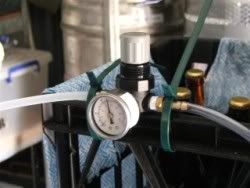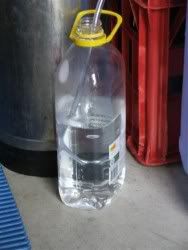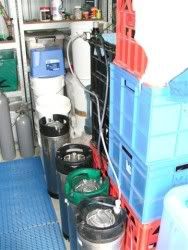Screwy
Well-Known Member
Chris77 said:I have just done a Woodfords kit and transfered it to my new corny, do I have to prime/condition it with sugar. Or is it best to force carb I have a CO2 setup, if force carbing what is the recommended psi.
Following this post I thought some would be interested in how to either carbonate/condition beer in a Cornie keg. This can be done by either natural carbonation using a German method suitable under the Purity Law (Reinheitsgebot) or a more traditional method of conditioning using sugar. The two methods are described below and are somewhat similar.
To do this you will need a gas QD, an adjustable pressure release valve (air/power tool shops usually have these for about AU$20) and some beerline and a gas QD. The adjustable valve can be set using a Co2 bottle and reg. Set the pressure release to bleed off excess pressure at whatever carbonation level you require for your beer style. The relief valve is connected via some beerline and a gas QD to the Cornie keg gas post. The relief outlet needs to be fitted with a length of beerline or PVC tube, this can then be placed into a bottle of water to act as an airlock. Left at ambient temp, once the fermenting beer reaches the desired carbonation pressure any additional Co2 is vented off, fermentation progress can be monitored by watching the bubbling airlock (bottle of water). Once bubbling has stopped for a few days it can be assumed that the beer has finished fermenting and is carbonted, it can then be refrigerated to serving temp ready to serve.
Feeding keg/cask fermentation is the difference between the two methods, for keg conditioning, the amount of priming sugar can be calculated using a priming calculator, this is added to the keg after filling and the keg closed up and the relief valve and airlock connected as above.
Feeding while adering to the German Purity Law or Reinheitsgebot is different. This method was described for me by Zwickel a few years ago and I use it for Weizens.
After chilling your wort remove some unfermented wort and place it in a sterile plastic juice bottle or the like and put this unfermented wort into the freezer, the remainder goes into the FV and is fermented as usual. The day before kegging remove the frozen unfermented wort (or Speise) and leave to thaw. Rack the fermented beer from the FV (to get it off the yeastcake) to a bottling bucket or spare FV and add the thawed unfermented wort and give a stir. Rack to the cornie and fit the relief valve and airlock as described above. The amount of unfermented wort (Speise removed to be added back depends upon the beer style and carbonation level required. The rule of thumb is for Lager beers use 5% of the wort and for Weizens 8% of the wort.
Hope this is helpfull, here are some pics of my setup.
Screwy
As you can see a bank of Cornies can be connected to one relief valve all carbonating together.






